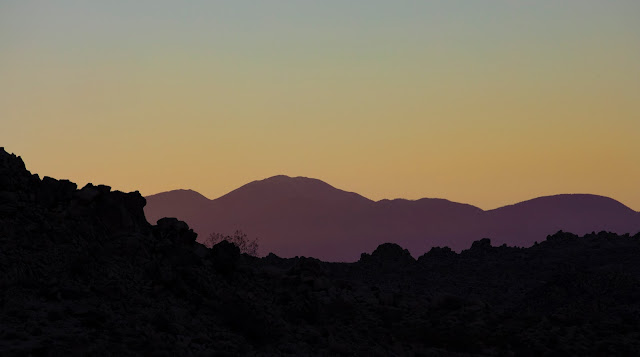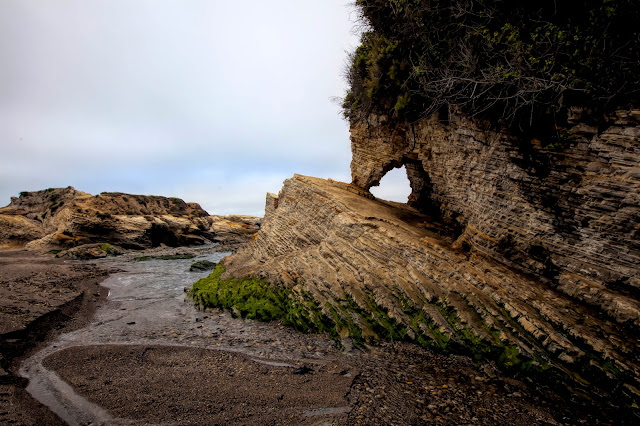I'm kicking off 2022 with one of my favorite hikes in Joshua Tree National Park. In the past, I've referred to it as Handprints Cave, but it's really more of a shelter than a cave, and has been used as a shelter by Native Americans many years ago. My first visit to this amazing spot was in November 2019, and I did it as a solo hike. My second visit was with my friend JP in January of 2020, and we ended up making it a loop hike, thinking it might be easier and more interesting. Well, more interesting, but definitely not easier! At one point in the loop, we hit a boulder-filled canyon that was very difficult to pass. Interestingly, I've looked all over my blog for this post and am unable to find it. I must have never posted, which is too bad, because it was a memorable hike with a lot of great photos.
Roger and I (red backpack), with the "red obelisk" in the background.
So this represents my third hike to Handprint Shelter, and Roger and Mitch are joining me on this one (credit goes to Mitch for the above photo). After studying Google Maps for hours, I'm confident we can repeat the loop hike but bypass the "canyon from Hell" section with the huge boulders. I have everything all mapped out on my Garmin, and we just need to turn left at a particular spot rather than continue right. Couldn't be easier, right? What could possibly go wrong?
 |
| Dinosaur rock... appears to be sniffing a tree! |
I was hoping to find a small pictograph site on the hike in.Can you see it? It's a faded pictograph in a remote and difficult to reach location, but I'm pleased that I was able to find it.
A close-up of the pictograph, with some color enhancement. It's unusual, and I've not seen another like it.
Underneath the pictograph rock is an area that could have been used as a shelter. Very interesting area! But it's time to continue on our hike.
Mitch and Roger taking pictures of petroglyph rock. There's reported to be another faded pictograph in this general location, but I was unable to find it.
We did find this interesting hollowed-out boulder. I looked inside but didn't see any rock art. To give it a thorough inspection, you would need to remove your pack and crawl in, which I didn't do. Maybe next time.
We spotted these pretty blooms on the hike in. The bees were loving it!
We finally make it to Handprint Shelter. This is such an amazing site that even on my third visit I was in awe. Just inside the shelter is a very large boulder with a grinding surface that looks like it's seen a lot of use. On top of the surface is what looks to be an original mano (grinding stone). The stone is large and heavy, and my guess is that it was used to crush large seeds and nuts (there are oak and pinion pine in the area). It's very rare to find a grinding surface with intact mano, so this is really a treat. And I'm pleased to see things are exactly as I left them on my last visit to this site.
I won't share all the pictographs at this site, as those have been shared previously. But I will say there are a lot more here than just handprints!
 |
| Roger and Mitch looking down into the Wonderland of Rocks. |
 |
| Grumpy rock |
Remember earlier when I said "What could possibly go wrong?" I think it was at this point that my confidence in finding the easier way through this rocky maze started to wane. My Garmin was pointing me in the direction of a huge hill of boulders. What looked like an easier route from satellite view on Google Earth was definitely NOT an easier route! So we had no choice, and proceeded up the "canyon from Hell", which is exactly what I was trying to avoid.
 |
| The struggle begins. |
I'm glad Mitch took the time to take a couple photos. I was so absorbed in trying to make it through these boulders without dying that it didn't even cross my mind. We eventually made it through and out the other end, but not without a struggle!
We finished the hike in semi-darkness after sunset. Here's a photo of Mitch capturing the last light of the day on the rocky peaks of the Wonderland of Rocks. A tough, challenging hike, and one I won't soon forget. Thanks for joining me on this one!
Stay safe and stay healthy!














































